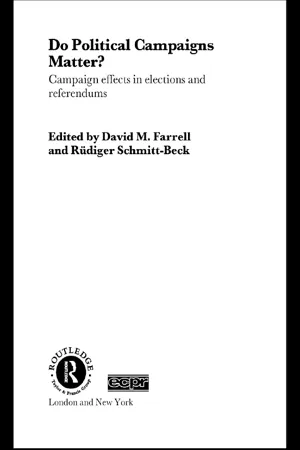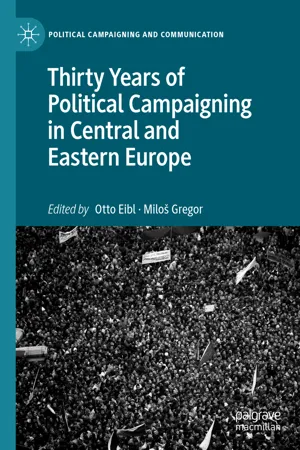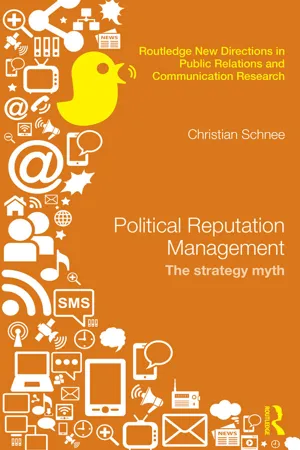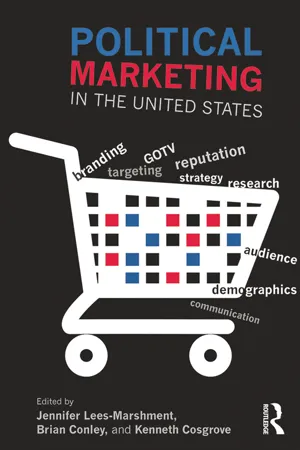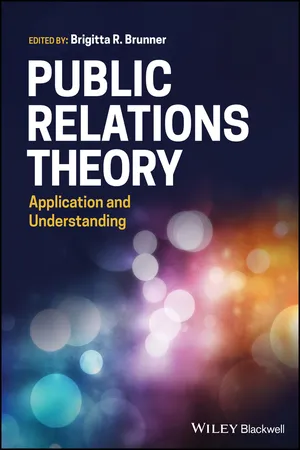Politics & International Relations
Political Campaigns
Political campaigns are organized efforts to influence the decision-making process within a specific political system. They are typically conducted by candidates, political parties, or interest groups to promote their agendas, gain support, and ultimately win elections. Campaigns often involve various strategies such as advertising, public relations, and grassroots mobilization to communicate their messages and persuade voters.
Written by Perlego with AI-assistance
Related key terms
Related key terms
1 of 4
Related key terms
1 of 3
5 Key excerpts on "Political Campaigns"
- eBook - ePub
Do Political Campaigns Matter?
Campaign Effects in Elections and Referendums
- David M. Farrell, Rüdiger Schmitt-Beck(Authors)
- 2003(Publication Date)
- Routledge(Publisher)
This book represents the first cross-national effort to take stock of the state of this sub-discipline. The nine chapters which follow examine campaign effects in a range of different national contexts, using a range of different methodologies. In this introductory chapter we set the scene for what is to follow. We start, in the first section, by outlining the field of study of campaign effects, setting out a definition of campaigning, and reviewing the types of campaigns that can be included in this area of analysis. The subsequent sections concentrate on campaigns for elections and referendums, exploring the core features of contemporary campaigns and discussing the range of likely ways in which these campaigns might be said to have some influence. Finally, we provide a short section reviewing the main trends in the study of campaign effects, before concluding with an outline of the rest of the book.The rise of campaign politics
Campaigning is a core feature of the political process in contemporary democracies. Election campaigns see parties and their candidates wage battles for votes and political office. Referendum campaigns see proponents and opponents of the relevant issue seek to steer the vote in their preferred direction. Issue-based campaigns see government agencies or interest groups attempting to have an issue or policy placed high on the political agenda, and to have it favourably framed in public debate. Image campaigns see efforts to paint the public perception of some political actor in a more favourable light. In the past few decades campaigning has assumed increasing relevance as a mode of political mediation, in part reflecting the growing volatility in the electoral process, in part also reflecting a general shift towards issue-based politics and a greater emphasis on alternative modes of political participation. If the first of these indicates a greater role for ‘policy mediation’ – consisting of top-down flows of strategic communication originating from the political elite – the second is more suggestive of a process of ‘interest mediation’, in which, in particular, the political elite face ever more competition for agenda setting from interest groups and lobbying organizations (Edelman 1985, 1988; Sarcinelli 1987, 1998; Röttger 1997; Bentde et al. 2001).Campaigns occur not only in the political realm; they are increasingly important in all walks of life: for instance, a company mounts an advertising campaign to promote its product; a charity seeks to raise money for an overseas aid programme; a city engages in ‘city marketing’ in order to attract investors and new businesses. Since the focus of this book is specifically on political - Otto Eibl, Miloš Gregor, Otto Eibl, Miloš Gregor, Otto Eibl, Miloš Gregor(Authors)
- 2019(Publication Date)
- Palgrave Macmillan(Publisher)
© The Author(s) 2019Begin AbstractO. Eibl, M. Gregor (eds.)Thirty Years of Political Campaigning in Central and Eastern Europe Political Campaigning and Communication https://doi.org/10.1007/978-3-030-27693-5_11. A Brief Historical Overview of Political Campaigning: Theories, Concepts, and Approaches
Otto Eibl1andMiloš Gregor1(1) Department of Political Science, Masaryk University, Brno, Czech RepublicKeywords Electoral campaign Political communication Cleavages Marketing management ElectionsEnd AbstractPolitical marketing has become a seemingly crucial part of the strategy political leadership employs when attempting to determine, refine, and prioritise policy and goals. Generally, it can be understood in two ways. First, it is a philosophy, an attitude, and a perspective. Second, it is a set of activities used to implement that philosophy (Crompton and Lamb 1986 ). In Western terms, although seldom recognised by politicians, the problem of getting elected is essentially a marketing one. “Political parties must determine the scope and nature of their product and then find the most effective way of communicating its benefits to a target audience.” (Reid 1988 , 34).As the political landscape of many countries is rapidly changing, the rising importance of effective political communications and marketing is visible in every democratic country around the world. Today, political marketing is understood as something far more than just presentation devices and advertising, it also relates to product management (Wring 1996- eBook - ePub
Political Reputation Management
The Strategy Myth
- Christian Schnee(Author)
- 2014(Publication Date)
- Routledge(Publisher)
2 Political communications management Understanding the context Political marketing When individuals, political parties or organizations deploy marketing concepts, theories and approaches to achieve objectives in a political context, we may refer to this activity as political marketing. The fundamental objectives of political marketing are addressing public perspectives and views, the propagation of political convictions, campaigning, winning majorities of the electorate, and finally, legislating with the intention to meet the expectations and hopes of particular segments of the electorate (Newman, 1999b). Newman (2002) contends that the marketing rationale helps understand why, how and to what purposes candidates, parties and government departments take strategic decisions. Hence marketing concepts appear to offer a valuable framework for a study that endeavours to grasp the degree to which strategic considerations and decisions feed into the political communications process (Harrop, 1990). Marketing strategy is described as the interface between any entity – political or not – and its surroundings, with particular regard to its key audiences (Mavondo, 2000). Lilleker et al. (2006) and Lilleker and Negrine (2006) emphasize the mutual nature of marketing in politics, which promises to satisfy both the electorate’s expectations and the organization’s needs - eBook - ePub
- Jennifer Lees-Marshment, Brian Conley, Kenneth Cosgrove(Authors)
- 2014(Publication Date)
- Routledge(Publisher)
The study of campaign crises remains in its infancy. Political marketing is more developed, but still struggling to define concepts and establish relationships with related subfields and other disciplines. Much remains to be learned, and both researchers and practitioners stand to benefit. This chapter builds on the limited available foundation in the literature by considering how changes in the external environment, particularly recent changes in the campaign finance landscape, could affect crisis-management with an eye toward political marketing. The case study illustrations add new insights that do not receive substantial attention in the existing literature. Three themes are particularly noteworthy for future research, as well as for understanding practice. These themes include greater attention to: (1) potential connections between public policy developments and campaign crises; (2) the presence of new actors in the campaign environment that can attempt to create or exploit crises for candidates they oppose, particularly through political advertising; and (3) emerging strategic and tactical considerations.The limited existing literature does not significantly contemplate the connection between public policy and crisis-management. The post-2010 developments discussed above show that policy changes can have a substantial impact on the campaign environment. Of course, legislative votes and other policy matters have always been a component of campaigning, but a policy issue that dramatically reshapes the campaign environment for all candidates is rare.For this chapter’s interest in theory-building, Citizens United provides an opportunity to explore how this major legal development—a public policy change—affected both the “rules” by which political marketers had to abide, and how the presence of new money and spenders—a political change—affected political communication. Importantly, the chapter does not suggest that Citizens United - eBook - ePub
Public Relations Theory
Application and Understanding
- Brigitta R. Brunner, Brigitta R. Brunner(Authors)
- 2019(Publication Date)
- Wiley-Blackwell(Publisher)
Both approaches define the process from different sides but both give a good idea in terms of how broad it is. Many scholars researching political communication provide their own definition of the field (C. Smith, 1990 ; Perloff, 2008 ; J. Miller & McKerrow, 2010 ; Campbell & Crilly, 2011 ; Rúas & Capdevila, 2017). Based on these definitions, however different, it becomes clear that the field of political communication can be very closely intertwined with public relations and is often influenced by theoretical knowledge and practice of that field (Schuetz, 2009). Interestingly, an international orientation, while central to communication science, and present in public relations as international PR, was not explored much in political communication until the 1990s (Esser & Pfetsch, 2004). Even now, political communication works are often centered on the United States (Canel & Sanders, 2012). What Is Government Relations? The second concept discussed in this chapter and also related to political public relations is government relations. Government relations is considered a part of an organization’s public relations efforts aimed at establishing, maintaining, and influencing relationships with legislative bodies in an effort to monitor and lobby on regulations that will affect their current and future operations (Taylor, 2013). There are four major stages in which organizations conduct government relations. In chronological order, organizational leaders have to be aware of the legislative agenda of the government in the area that is of interest to their organization. The second step is obtaining as much information as possible about how potential acceptance or rejection of legislative plans affect the short‐ and long‐term operations of the organization. In an effort to disseminate information about the organization’s position on the issue, the next step is often to distribute messages that outline the desired outcome from the organization’s perspective
Index pages curate the most relevant extracts from our library of academic textbooks. They’ve been created using an in-house natural language model (NLM), each adding context and meaning to key research topics.
Explore more topic indexes
Explore more topic indexes
1 of 6
Explore more topic indexes
1 of 4
